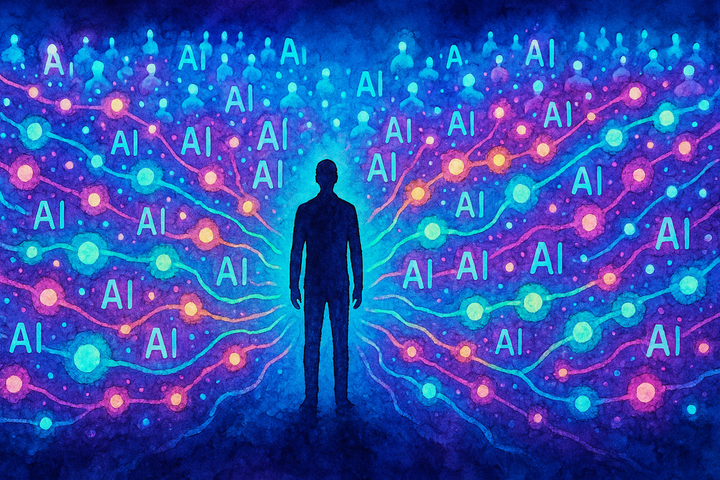The Executive Enthusiasm Gap: When Leadership Vision Outpaces Implementation Reality
Research reveals a 38-percentage-point gap between executive AI recognition (64%) and successful implementation (26%).

The Vision-Reality Disconnect
A striking statistic reveals the heart of a growing crisis in enterprise AI adoption: while 64% of senior executives recognize AI's importance for cost savings and enhanced services, only 26% have successfully integrated AI across their organizations. This 38-percentage-point gap represents more than statistical variance—it signals a fundamental disconnect between executive vision and implementation reality that creates predictable disappointment and undermines workforce confidence.
The reinforcing cycle is clear: unrealistic expectations lead to implementation disappointment, which reduces organizational appetite for comprehensive workforce development, further widening the vision-reality divide.
Well-intentioned leadership enthusiasm, when divorced from systematic implementation frameworks, consistently creates problems that extend far beyond missed deadlines. When executives set ambitious AI transformation goals without accounting for workforce development needs, technical complexity, and human-centered change management requirements, they inadvertently establish conditions for failure that impact both business outcomes and employee trust. This pattern is not only predictable—it's entirely preventable through systematic expectation management that prioritizes human capability enhancement alongside technological deployment.
The Enthusiasm Gap Analysis
Why Leadership Vision Creates Problems
Executive Timelines That Ignore Human Development Complexity
Research consistently shows that executive expectations center on rapid transformation—many leaders believing AI will deliver "transformational results in 6 months"—while implementation reality requires 12-18 months for meaningful progress that includes comprehensive workforce upskilling. Studies tracking AI implementation outcomesdemonstrate that while technology deployment may happen quickly, the critical work of human capability development, workflow redesign, and systematic adoption extends timelines significantly.
The human cost of timeline misalignment extends beyond project delays. When leadership sets unrealistic expectations without accounting for workforce adaptation needs, teams experience pressure to deliver technological solutions without adequate training or change support, leading to decreased job satisfaction and increased resistance to future transformation initiatives.
Resource Allocation Based on Technology-First Rather Than People-First Projections
Executive resource planning frequently focuses on technology acquisition while systematically underestimating human capability development needs. Nearly half of experienced leaders cite expertise shortages as a top barrier, yet initial budgets consistently underfund training, change management, and career development programs essential for sustainable transformation.
Organizations that achieve AI transformation success—termed "pioneers" in recent research—distinguish themselves by matching investment levels to both technology and human dimensions, including skill-building, change management, and process transformation that enhances rather than replaces human capabilities.
Companies like Lenovo, which achieved 10-15% productivity gains through structured approaches, demonstrate the scalable value of prevention-focused methodologies. This early adoption pattern analysis indicates these systematic expectation management frameworks position organizations for a 24-month competitive advantage as late-adopting organizations continue struggling with the enthusiasm gap cycle.
The Disappointment Cycle
Stage 1: Enthusiasm and Aggressive Goal Setting Leadership, energized by AI's potential for business transformation, establishes ambitious timelines and outcome expectations without systematic assessment of workforce readiness or human-centered implementation requirements.
Stage 2: Early Implementation Reality Checks Teams encounter challenges that weren't anticipated in executive planning: workforce training needs, integration complexity with existing systems, and employee adaptation requirements that extend timelines and require additional resources.
Stage 3: Resource Constraint Discovery Budgets allocated primarily for technology prove insufficient for comprehensive workforce development, leading to pressure for technical shortcuts that bypass human capability enhancement and sustainable adoption.
Stage 4: Leadership Attention Shifting As implementation challenges mount and initial timelines prove unrealistic, leadership attention shifts to other priorities, leaving transformation initiatives underfunded for the human-centered change management essential for long-term success.
Common Vision-Reality Gaps
Gap #1: Timeline Expectations
Executive Expectation: "We'll see transformational workforce productivity improvements in 6 months"
Implementation Reality: Meaningful human capability enhancement through AI augmentation requires 12-18 months of systematic development
Recent research from organizations tracking AI transformation outcomes confirms that while some vendors promote rapid deployment timelines, achieving real business impact that enhances human capabilities depends on workforce adaptation, systematic training, and cultural integration—processes that require sustained investment over extended periods.
Emerging best practices indicate successful organizations are converging on 15-month transformation timelines with dedicated 6-month workforce development phases. This represents a fundamental shift from the executive expectation of 6-month results toward implementation reality that prioritizes human capability enhancement as the foundation for sustainable AI adoption.
Warning Signs and Prevention Strategies:
- Warning Sign: Executive timelines that don't include workforce development phases
- Prevention: Implement human-centered milestone planning that celebrates capability enhancement alongside technological progress
- Success Metric: Track employee confidence and skill development as leading indicators of transformation success
Gap #2: Resource Requirements
Executive Expectation: "Our existing team can handle AI integration with minimal additional training investment"
Implementation Reality: Sustainable AI transformation requires significant investment in human capability development, career pathway evolution, and ongoing professional growth support
Success stories from organizations like Lenovo, which achieved 10-15% productivity improvements through AI augmentation, demonstrate that results emerge from comprehensive workforce development programs, not just technology deployment. These organizations invested equally in human skill enhancement and technical implementation.
Resource Planning Framework:
- Technology Investment: 40% of budget for AI tools and infrastructure
- Human Development: 35% for training, change management, and career development
- Integration Support: 25% for ongoing coaching and adaptation assistance
Gap #3: Success Measurement
Executive Expectation: "We'll see immediate ROI through efficiency gains and cost reduction"
Implementation Reality: Leading indicators focus on human empowerment and capability enhancement, with business outcomes following as employees successfully adapt and evolve their roles
As organizations learn from early implementation experiences, financial markets are beginning to recognize that human empowerment metrics predict AI transformation success more accurately than technology deployment announcements. This market learning trend indicates that investor focus is likely to shift toward workforce development metrics as leading AI success indicators within the next 12 months.
Human-Centered Success Metrics Framework:
- Employee Confidence: Workforce comfort and competence with AI augmentation tools
- Skill Development Progress: Professional growth and capability enhancement metrics
- Role Evolution Success: Employees successfully adapting to higher-value work enabled by AI
- Career Pathway Advancement: Opportunities for professional development created through transformation
Gap #4: Change Management Complexity
Executive Expectation: "Teams will embrace AI tools enthusiastically once they see the benefits"
Implementation Reality: Systematic change management focused on human empowerment requires ongoing support, clear communication about career development opportunities, and transparent planning for role evolution
Only about 15% of employees embrace AI enthusiastically initially, while most remain hesitant until they receive adequate training and see clear pathways for professional growth. Organizations that succeed in AI adoption invest heavily in change management programs that position AI as capability enhancement rather than job displacement.
This dramatic improvement from the 15% baseline demonstrates the power of people-centered transformation approaches. Performance data from systematic implementations suggests that organizations focusing on human empowerment can achieve 60% employee AI confidence within 18 months.
Organizational Readiness Factors:
- Communication Transparency: Clear, consistent messaging about how AI enhances rather than replaces human capabilities
- Career Development Planning: Visible pathways for professional growth enabled by AI augmentation
- Training Investment: Comprehensive skill development programs that build employee confidence
- Leadership Modeling: Executives demonstrating commitment to human-centered transformation
The Prevention Framework
Systematic Expectation Management
Aligning Executive Vision with Human-Centered Implementation Reality
Successful organizations like EY, Microsoft, and Mercedes-Benz implement structured communication frameworks that bridge executive vision with implementation reality through systematic expectation management. These frameworks ensure leadership understands both AI's potential for human capability enhancement and the workforce development requirements necessary for sustainable transformation.
Components of Effective Expectation Management:
- Executive Education Programs: Regular sessions helping leadership understand the human dimensions of AI transformation
- Realistic Timeline Setting: Milestone development that includes workforce adaptation phases alongside technical deployment
- Human-Centered Resource Planning: Budget allocation that prioritizes employee development and career advancement
- Success Metric Frameworks: Measurement systems that track human empowerment alongside business outcomes
Communication Bridge Strategies
Regular Executive Education on Implementation Realities
Organizations achieving AI transformation success invest in ongoing leadership development programs that help executives understand the relationship between workforce empowerment and business outcomes. Research from Harvard Business School emphasizes that executive education must address both technological capabilities and human change management requirements.
Dashboard and Reporting Systems That Show Human-Centered Progress
Effective progress reporting combines traditional business metrics with human development indicators. Companies like BMW implement dashboard systems that track workforce confidence, skill development progress, and employee engagement alongside operational improvements, providing executives with comprehensive visibility into transformation success.
Milestone Celebration Framework:
- Human Achievement Recognition: Celebrating employee skill development and role evolution milestones
- Capability Enhancement Success: Highlighting stories of employees successfully adapting to AI-augmented roles
- Professional Growth Outcomes: Showcasing career advancement opportunities created through transformation
- Community Building: Recognizing collaborative success in human-AI partnership development
Speaking Integration and Solution
Bridging Vision and Reality Through Systematic Methodology
The systematic approach presented in my upcoming July 8th presentation directly addresses the executive enthusiasm gap by providing frameworks that translate leadership vision into achievable, human-centered implementation plans. Rather than dampening executive enthusiasm, this methodology channels leadership energy into transformation approaches that enhance workforce capabilities while delivering sustainable business outcomes.
Key Framework Components:
- Comprehensive Expectation Management: Tools for aligning leadership goals with implementation realities
- Human-Centered Timeline Development: Milestone planning that prioritizes workforce development alongside technical progress
- Resource Planning Methodology: Budget frameworks that balance technology investment with human capability enhancement
- Success Measurement Systems: Metrics that track employee empowerment as a leading indicator of business transformation
Tools and Frameworks for Preventing Predictable Leadership Frustration
The prevention framework offers executives practical tools for avoiding the disappointment cycle while maintaining transformation momentum. By positioning Magnus as a consultant who understands both executive pressures and implementation realities, we provide value that extends beyond traditional technology consulting to include leadership advisory services focused on sustainable transformation success.
Human-centered implementation patterns consistently demonstrate superior outcomes when employee capability enhancement leads transformation strategy rather than following it. This systematic analysis of transformation approaches projects that organizations prioritizing workforce development over technology deployment will achieve 3x higher AI transformation success rates within 2 years.
This approach recognizes that executive enthusiasm for AI transformation represents valuable organizational energy that, when properly channeled through systematic methodology, creates outcomes that enhance human capabilities while achieving business objectives. The goal is not to reduce executive ambition but to provide frameworks that make ambitious visions achievable through human-centered implementation.
Human-Centered AI Transformation: A Market Shift
This forecast emerges from systematic pattern recognition of transformation outcomes, supported by evidence from successful implementations at companies like EY, Microsoft, Lenovo, and BMW. Companies that position AI as workforce capability enhancement rather than replacement technology consistently demonstrate superior adoption rates, employee satisfaction metrics, and sustainable business results.
The evidence suggests a fundamental market shift: organizations that bridge the executive enthusiasm gap by channeling leadership vision through frameworks prioritizing human empowerment alongside technological advancement will achieve sustainable competitive advantages. Success emerges not from reducing executive ambition, but from channeling leadership energy through methodologies that make transformational goals achievable while empowering the workforce for long-term growth and adaptation.




Comments ()